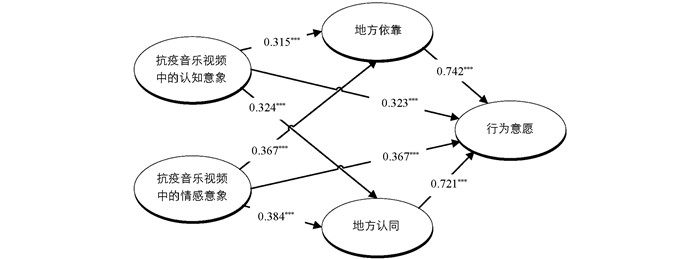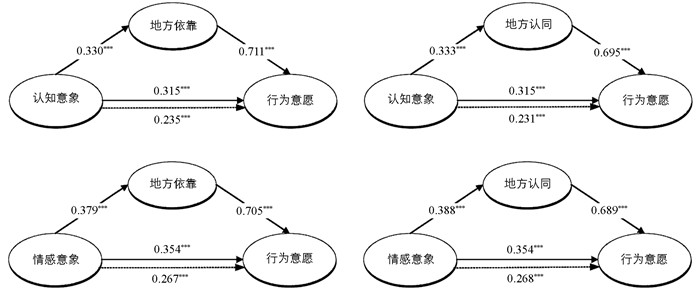-
自新冠肺炎疫情爆发以来,世界旅游业受到了极大的冲击.尤其是中国武汉,作为此次新冠肺炎疫情的重灾区,从2020年1月23日宣布封城到4月8日解封,两个多月的疫情阻击战让旅游活动被迫中断,旅游周边产业更是损失惨重.根据2020年4月30日武汉市统计局发布的数据,受疫情影响,武汉市2020年一季度第三产业增加值下降37.7%,服务业生产大面积停滞,住宿业和餐饮业等增加值分别下降39.8%和56.5%.在经历了几近断崖式的下跌后,武汉市旅游业如何通过深入人心的营销活动改变潜在旅游者的态度,激发出游行为,助力产业全面复苏,成为现阶段的核心议题.
疫情期间,媒体平台上涌现出大量的抗疫音乐视频,在传递武汉抗疫正能量的同时,也让关心武汉的公众从侧面重新认识了“英雄武汉”的美丽风光.音乐视频通过听觉和视觉等多感官的形象塑造方式向外界传播了独具特色的武汉形象,传递了积极向上的武汉精神,引发了强烈的社会关注和响应,也为疫情背景下旅游目的地营销提供了新的视角.在疫情背景下,是否可以通过多感官的营销方式促进潜在旅游者理解地方意象、形成地方依恋、产生行为意愿,助推疫情后旅游业的恢复发展,有待进一步实证研究.
地方意象是人对地方所持有的信仰、印象和想法的集合[1-2],地方意象对人的态度与行为影响已得到环境心理学、地理学和营销学等多学科的验证[3].地方意象一般包括认知意象与情感意象两个维度[4],认知意象即人对目的地的信仰、属性和了解程度的集合[5];情感意象即人对目的地的感觉与情感联结[6].对于未曾到访的地方,潜在旅游者持有的地方意象依赖于他们所接触的社会网络,来源于对地方历史文化的了解,通过好友推荐、书籍报纸、网络新闻和音乐视频等方式获取目的地信息,形成个人印象.潜在旅游者能否转化为现实游客,地方意象是一个重要的影响因素[7].
地方依恋是个体表现出与特定地方相亲近的情感倾向[8],是人与地方相互作用产生的情感联系[9].一般认为,地方依恋由地方依靠和地方认同两个维度构成[10],地方依靠是人与地方之间的一种功能性依恋,地方认同是人与地方之间的一种情感依附[11].文献研究表明,地方意象与地方依恋都属于态度范畴,具有认知与情感成分,并影响决策行为[12].在旅游学中,行为意愿是一个人主观判断其未来产生旅游行为的倾向[13],是旅游者参与某种旅游活动的意愿[12].在疫情这一特殊背景下,地方意象、地方依恋与行为意愿之间的关系值得进一步探究.
总之,地方意象是客观目的地在旅游者主观世界中的反映,通过“人与地”之间双向互动形成[14];地方依恋是人与特定地方之间的情感联结,是“人对地”的单向情感反映[14];行为意图是主观判断“人与地”互动行为产生的意愿.疫情背景下,潜在旅游者在观看抗疫音乐视频时,视频中所呈现的地方意象能否促进地方情感产生,触发行为意愿,需要进一步的理论解释和实证检验.
全文HTML
-
感官体验是人们感知世界、获取外界信息的基础手段,通过对感官体验的操控能够有效地影响消费者行为[15]. Krishna提出感官营销是指融入消费者的5种感官体验(视觉、听觉、味觉、嗅觉和触觉),并影响消费者的感知、判断和行为的营销方式[16],相应的产品构建也是多感官维度的[17].感官营销搭建起消费者与品牌之间的多感官对话桥梁,不仅让消费者的体验得到扩展,而且在多维感官的综合作用下,消费者对品牌和产品的辨别能力得到显著提升.与此同时,感官营销不仅为营销者提供了新的营销方式,也让消费者在感官体验、心理感受及行为意愿之间形成了强关联[18].
在旅游者认知目的地的过程中,感官体验具有首要作用.目的地感官营销需要借助对旅游者“五感”强烈的信息刺激和恰当的感官表达,才能在“感官—心理—行为”反应模式下对旅游者产生最佳的营销效果[18].以往的目的地营销研究聚焦在定位识别[19]、口号设计[20]、形象塑造[21]和品牌建设[22]等营销策略方面,通过不断寻求各类新的营销工具,如微博[23]、微信[24]、电影[25]和音乐视频等渠道和媒介对旅游者心理和行为产生影响.然而,以往研究忽略了对营销受众基础感官的系统性思考[15],对目的地的塑造与营销过度地倚重视觉,忽视了其他感官媒介的传递作用[26].在现有的目的地营销中,缺乏目的地与潜在旅游者之间多感官渠道的沟通,致使目的地的综合吸引力难以充分释放.因此,目的地营销需要弥补非视觉感官的短板[18].
音乐视频中的地方意象能够促使潜在旅游者通过具体的感官知觉形成感知意象,影响旅游者的认知形成与决策行为[15].本研究以感官营销理论为基础,以音乐视频的视觉、听觉刺激为切入点,探讨了抗疫音乐视频中的地方意象对潜在旅游者态度与行为的影响机制,以期为目的地意象传播、精准感官营销提供理论依据与方法指导.
-
地方意象与地方依恋均属于态度范畴,具有认知与情感成分[27].地方意象是地方依恋产生的基础[28],人往往借由各种渠道的信息对特定地方产生认知,继而整合为意象,再融入内心的情感,最后才生成对特定地方的依恋[14].地方意象是地方依恋的前因变量[29-30],且地方意象对地方依靠和地方认同两个维度均具有显著的正向作用[29-30].范钧等[31]研究旅游地意象、地方依恋与旅游者环境责任行为之间的影响关系,提出旅游地意象对地方依恋具有正向影响.基于此,本研究提出:
假设1(H1)抗疫音乐视频中的地方意象对潜在旅游者地方依恋具有正向作用.
H1a 抗疫音乐视频中的认知意象对潜在旅游者地方依靠具有正向作用;
H1b 抗疫音乐视频中的情感意象对潜在旅游者地方依靠具有正向作用;
H1c 抗疫音乐视频中的认知意象对潜在旅游者地方认同具有正向作用;
H1d 抗疫音乐视频中的情感意象对潜在旅游者地方认同具有正向作用.
-
根据Crompton[32]的目的地选择域理论,旅游决策是一个连续过程,旅游者基于目的地地方意象和属性感知做出满足需求的目的地决策[33].地方意象是旅游决策的关键基础[2],游客倾向于选择具有强烈地方意象的目的地[27],且认知意象和情感意象对旅游者行为意愿均具有正向作用[34-35]. Urry[36]认为游客对旅游目的地的选择受电影、电视、唱片、录像和文学作品等非旅游因素建构形象的影响. Jin等[37]认为传播目的地歌曲能够吸引营销受众的注意,唤起到访意愿;朱竑等[38]从认知形象和情感形象两个层面探讨了歌曲对旅游者西藏形象感知的影响,并论证了藏族歌曲与旅游者决策的关系.基于此,本研究提出:
假设2(H2)抗疫音乐视频中的地方意象对潜在旅游者行为意愿具有正向作用;
H2a 抗疫音乐视频中的认知意象对潜在旅游者行为意愿具有正向作用;
H2b 抗疫音乐视频中的情感意象对潜在旅游者行为意愿具有正向作用.
-
旅游行为意愿,是一个人主观判断其未来产生旅游行为的倾向[13],是游客参与某种旅游活动的意愿[12]. Alexandris等[39]研究发现,地方依靠和地方认同在预测希腊滑冰者的重游意愿中扮演了重要作用;Kil等[40]以美国国家森林公园为例,证实了游客地方依靠和地方认同与重游意愿之间存在一定的作用关系;Lee等[41]认为城市公园游憩者的地方依靠和地方认同显著作用于其行为意愿;Xu和Zhang[42]也认为,地方认同对到访杭州的旅游者行为意愿具有重要作用,地方依靠对游客的重游行为意愿具有正向作用.由此,本研究提出:
假设3(H3)潜在旅游者地方依恋对其行为意愿具有正向作用.
H3a 潜在旅游者地方依靠对其行为意愿具有正向作用;
H3b 潜在旅游者地方认同对其行为意愿具有正向作用.
-
地方依恋作为较为稳定持久的、人与特定地点之间的情感变量,其前因变量包括地方意象[27, 43];并且地方依恋对行为意愿具有重要作用,且正向影响不同阶段的游客行为意愿[44].范钧等[31]探讨了旅游地意象、地方依恋与旅游者环境责任行为之间的关系,验证旅游地地方意象通过地方依恋间接影响旅游者环境责任行为.邱宏亮[45]以杭州西溪花朝节为例,探讨了旅游节庆意象、节庆依恋、节庆游客环境责任态度与行为之间的关系,证实节庆依恋在花卉意象与游客环境责任行为之间存在部分中介作用,在活动意象和配套意象与游客环境责任行为之间存在完全中介作用.具有地方意象的音乐视频可以通过视觉、听觉等多感官途径传递信息,促进潜在旅游者地方依恋的形成,进而影响潜在旅游者的决策行为.由此,本研究提出:
假设4(H4)潜在旅游者地方依恋在抗疫音乐视频中的地方意象与行为意愿之间具有多重中介作用.
H4a 潜在旅游者地方依靠在抗疫音乐视频中的认知意象与行为意愿之间具有中介作用;
H4b 潜在旅游者地方依靠在抗疫音乐视频中的情感意象与行为意愿之间具有中介作用;
H4c 潜在旅游者地方认同在抗疫音乐视频中的认知意象与行为意愿之间具有中介作用;
H4d 潜在旅游者地方认同在抗疫音乐视频中的情感意象与行为意愿之间具有中介作用.
通过文献综述和研究假设,得到本研究的理论模型(图 1).
1.1. 感官营销理论
1.2. 抗疫音乐视频中的地方意象对地方依恋的影响
1.3. 抗疫音乐视频中的地方意象对行为意愿的影响
1.4. 地方依恋对行为意愿的影响
1.5. 地方依恋在抗疫音乐视频中的地方意象与行为意愿之间的中介效应
-
本研究选择众多抗疫音乐视频中的典型代表《武汉伢》作为研究素材,该音乐视频由17名文艺工作者创作,于2020年1月27日发布,之后通过中央电视台剪辑音乐视频传播而倍受关注. 《武汉伢》音乐视频中选取了黄鹤楼、江汉路、长江大桥、户部巷和武汉大学等标志性景观,在传达抗疫精神的同时,让大众了解了武汉独具特色的地方意象.
-
本研究主要借鉴现有的成熟量表作为测量工具,题项采用Likert 7分量表进行测量.对于音乐视频中的地方意象,从认知意象和情感意象两个维度进行测量.认知意象是借鉴Lew[46]与Chen[47]的量表,并结合《武汉伢》音乐视频画面与弹幕,提取出街头景象、城市景观、地理景观和地域特色等4个方面进行测量;情感意象从“愉快” “兴奋” “唤起” “放松” 4个方面进行测量[48].地方依恋是根据Williams和Roggenbuck[49]研究,主要从地方依靠和地方认同两个维度进行测量,地方依靠4个测量题项是“更令人向往的旅游地” “无其他旅游景点可比” “旅游风光更陶醉” “旅游体验更好”;地方认同4个测量题项是“具有特别意义” “了解自我” “武汉一份子” “亲密情感联系”.行为意愿主要从到访意愿、推荐与谈论意愿、优先选择[50] 3个方面进行测量.此外,还设计了基本的人口统计学特征相关题项.
-
在问卷调查中,首先引导参与者观看音乐视频《武汉伢》至少90 s以上,然后再填写问卷.初试问卷通过网络发放,共计回收问卷111份,有效问卷107份,有效回收率为96.4%.调研对象排除了当前常住武汉或在武汉出生长大的人.使用SPSS 22.0对初试问卷进行信度检验和探索性因子分析.信度检验结果表明认知意象、情感意象、地方依靠、地方认同和行为意愿5个维度的Cronbach's α系数分别是:0.763,0.761,0.935,0.870,0.741,信度得分均大于0.7,说明该问卷信度良好.接着对问卷数据进行探索性因子分析,KMO值为0.864,并顺利抽取出认知意象、情感意象、地方依靠、地方认同和行为意愿5个因子,共解释了数据中68.79%的变异.根据公因子提取的数据结果,删除了公因子提取值较低的题项,最终得到由15个题项测量的5个因子.本研究以此为基础形成了正式问卷.
正式调研采用网络问卷形式,调研时间为2020年3月23-31日.共计回收问卷1 184份,剔除填写时间在120 s以下的问卷和明显大量选择相同选项的问卷,最后得到有效问卷945份,有效回收率为79.81%.在样本数据中,男女比例较为均衡,占比分别为47.62%和52.38%;年龄以18~40岁为主,占比为82.33%,这与青年人群更愿意关注网络信息相关;学历本科以上占比为67.09%,这符合高学历人群更关注旅游活动、更关注音乐视频的现实情况;收入层次分布较均衡;47.41%的受访者有武汉到访史,对武汉有一定程度的了解.总体上样本数据适合本研究.
2.1. 研究素材选取
2.2. 测量量表设计
2.3. 问卷初试优化与正式数据收集
-
研究首先对各变量的均值M和标准差σSD进行统计分析,结果表明受访者对抗疫音乐视频中的情感意象赞同程度(M=5.70,σSD=1.318)稍高于音乐视频中的认知意象赞同程度(M=5.51,σSD=1.295);受访者对地方认同赞同程度(M=3.62,σSD=1.728)稍高于地方依靠赞同程度(M=3.31,σSD=1.662),对行为意愿赞同程度相对较低(M=3.72,σSD=1.738).总体上来说,受访者对音乐视频中的地方意象赞同程度相对较高,对地方依恋和行为意愿的赞同程度相对较低.
研究对各维度进行因子分析.结果显示,所有变量的Cronbach's α系数均达到0.7水平,组合信度(CR)也在0.7以上,表明问卷具有良好的信度.根据CFA效度检测结果,每个CFA因子荷载都大于0.5,平均变异相取量(AVE)均大于0.5,表明本研究的测量项有较高的聚敛效度(表 1).
-
变量的相关性分析见表 2,主要变量之间具有较强的相关性.研究继续计算了AVE的平方根,并通过比较AVE与变量相关系数,进一步验证变量的区分效度.结果表明,本研究中任何两个变量之间AVE的平方根均高于两者之间的相关系数,因此,数据的区分效度较好.总体上,问卷数据具有较好的信度和效度水平.
-
采用层次回归分析方法对直接效应进行检验,回归分析表明在95%的置信区间下,F和t检验中各回归方程的线性关系和回归方程系数均具有统计学意义,结果见表 3.抗疫音乐视频中的认知意象(β=0.315,p<0.001)和情感意象(β=0.367,p<0.001)对潜在旅游者地方依靠存在具有统计学意义的正向影响,认知意象(β=0.324,p<0.001)和情感意象(β=0.384,p<0.001)对潜在旅游者地方认同存在具有统计学意义的正向影响,且情感意象比认知意象对地方依恋的影响稍大,假设H1a,H1b,H1c和H1d得到验证.抗疫音乐视频中的认知意象(β=0.323,p<0.001)和情感意象(β=0.367,p<0.001)对潜在旅游者行为意愿存在具有统计学意义的正向影响,且情感意象比认知意象对行为意愿的影响稍大,假设H2a和H2b得到验证.潜在旅游者地方依靠(β=0.742,p<0.001)和地方认同(β=0.721,p<0.001)对行为意愿存在具有统计学意义的正向影响,且地方依靠比地方认同对行为意愿的影响稍大,假设H3a和H3b得到验证.研究中的直接效应均成立,结果见图 2.
-
研究主要运用SPSS PROCESS宏程序进行中介效应检验,采用Bootstrap检验方法,抽样数为5 000,偏差校正95%的置信区间.对地方依恋多重中介效应的检验,以地方依靠和地方认同作为中介变量(M1,M2),检验抗疫音乐视频中的认知意象与情感意象自变量(X1,X2)对行为意愿应变量(Y)的影响,结果见表 4.
查看模型的总效应、直接效应与间接效应(表 4和图 3).结果表明,抗疫音乐视频中的认知意象与行为意愿之间的总效应为0.315(p<0.001),地方依靠作为中介时直接效应为0.081(p<0.05),总的间接效应为0.235(p<0.001);地方认同作为中介时直接效应为0.084(p<0.05),总的间接效应为0.231(p<0.001).由此,音乐视频中的认知意象在地方依靠和地方认同与行为意愿之间存在部分的中介效应,假设H4a和H4b成立.音乐视频中的情感意象与行为意愿之间的总效应为0.354(p<0.001),地方依靠作为中介时直接效应为0.087(p<0.01),总的间接效应为0.267(p<0.001);地方认同作为中介时直接效应为0.086(p<0.01),总的间接效应为0.268(p<0.001).由此,抗疫音乐视频中的情感意象在地方依靠和地方认同与行为意愿之间存在部分的中介效应,假设H4c和H4d成立.因此,地方依恋在抗疫音乐视频中的地方意象与行为意愿之间存在多重的部分中介效应,假设H4获得支持.
3.1. 测量模型检验
3.1.1. 描述性统计与因子分析
3.1.2. 相关性与区分效度检验
3.2. 假设检验
3.2.1. 直接效应检验
3.2.2. 多重中介效应检验
-
本研究以新冠肺炎疫情为背景,以感官营销理论为指导,探讨了抗疫音乐视频中的地方意象对潜在旅游者地方依恋与行为意愿的作用机制,拓展了旅游者决策理论,丰富了音乐视频在旅游研究中的应用.本研究结论如下.
第一,重大疫情下,抗疫音乐视频中的认知意象(β=0.315,p<0.001)和情感意象(β=0.367,p<0.001)对潜在旅游者地方依靠存在显著的正向影响;认知意象(β=0.324,p<0.001)和情感意象(β=0.384,p<0.001)对潜在旅游者地方认同存在显著的正向影响,且情感意象影响程度高于认知意象.本结论证实了在重大疫情下,抗疫音乐视频中的地方意象对潜在旅游者地方依恋具有重要的前因影响,情感意象比认知意象对潜在旅游者地方依恋影响更大.该结论与徐海军等[18]研究结果一致,即旅游者对目的地歌曲所传递的目的地形象中情感形象评价高于认知形象;同时验证了Kim等[51]情感形象评价高于认知形象的结论.该研究结论为疫情背景下旅游目的地形象分类营销提供了理论支持.
第二,重大疫情下,抗疫音乐视频中的认知意象(β=0.323,p<0.001)与情感意象(β=0.367,p<0.001)对潜在旅游者行为意愿存在显著的正向影响;潜在旅游者地方依靠(β=0.742,p<0.001)和地方认同(β=0.721,p<0.001)对其行为意愿存在显著的正向影响.本结论表明抗疫音乐视频中的情感意象影响程度要高于认知意象,地方依靠的影响程度要高于地方认同.本结论证实了在重大疫情下,抗疫音乐视频中的地方意象和潜在旅游者地方依恋对其行为意愿具有重要的影响,情感意象比认知意象更能影响行为意愿,地方依靠比地方认同更能影响行为意愿,为疫情背景下针对潜在旅游者行为决策营销提供了理论支持.
第三,重大疫情下,潜在旅游者地方依靠(β=0.235,p<0.001)在抗疫音乐视频中的认知意象与行为意愿之间具有部分的中介作用,地方认同(β=0.231,p<0.001)在认知意象与行为意愿之间具有部分的中介作用;地方依靠(β=0.267,p<0.001)在情感意象与行为意愿之间具有部分的中介作用,地方认同(β=0.268,p<0.001)在情感意象与行为意愿之间具有部分的中介作用.本结论证实了在重大疫情下,潜在旅游者地方依靠和地方认同分别在认知意象、情感意象和行为意愿之间具有部分中介作用,地方依恋具有中介传导作用.该研究结论也进一步验证了Prayag等[27]和范钧等[31]等关于地方意象、地方依恋与行为意愿之间的相互作用关系,为疫情背景下目的地针对旅游者态度与行为的精准营销提供了理论支持.
在以往的旅游研究中,针对特殊情境下音乐视频中的地方意象研究尚欠缺,且关注音乐视频中的地方意象对旅游者态度与行为共同影响的研究较少.因此,本研究创新性地探讨了抗疫音乐视频中的地方意象对地方依恋和行为意愿的影响,拓展了旅游者决策理论,丰富了音乐视频在旅游研究中的应用,补充了音乐学、地理学和旅游学之间的跨学科研究.
-
此次新冠肺炎疫情对世界旅游业带来了极大的冲击,旅游目的地如何促进潜在旅游者的态度转变与决策行为,将成为决定旅游目的地未来营销的主要方向.本研究结合理论发现,提出以下重大疫情下目的地营销的管理对策.
第一,重大疫情下旅游目的地营销应充分利用感官信息通道,采用多感官渠道传播目的地地方意象,增强潜在旅游者对目的地的认知意象与情感意象,着重强调情感意象的作用.疫情中旅游目的地营销应多渠道拓展地方意象的传播,触发潜在旅游者内隐的“感官—心理”联系,使潜在旅游者心中烙下“感官印记”.旅游目的地可利用多样化音乐视频传播渠道,通过反复循环刺激潜在旅游者听觉与视觉,以“音乐视频场景”不断地同潜在旅游者进行“感官交流”,强化潜在旅游者对地方意象的感官体验,形成独特的感官印象.同时,积极创作以展现地方意象为主的音乐视频、微电影和文学作品等文化产品,利用感官营销作为潜意识的触发器,渲染情感氛围,使潜在旅游者产生共鸣与联想,加强潜在旅游者对目的地的情感联系.旅游目的地营销应以感官营销理论作为指导,注重由目的地信息到潜在旅游者感官感知的跨越,通过多感官协同效应将地方意象传播给潜在旅游者,从而影响旅游者的认知形成与决策行为[15].
第二,重大疫情下旅游目的地营销应增强潜在旅游者对目的地的地方依恋.旅游目的地应着重宣传优质旅游资源,完善旅游设施,提升旅游服务,呈现给潜在旅游者一个旅游功能齐全的目的地环境,以沉浸式的旅游体验促进潜在旅游者对目的地的功能性依赖;同时创作带有感情渲染的文化作品,借助情感化营销宣传手段,让潜在旅游者能够在疫情时通过目的地了解自我,加强与目的地的情感联系,从而增强潜在旅游者对目的地的情感性依附.旅游目的地宣传应及时调整营销方案,例如以公益活动的形式为抗疫英雄们提供免费景区门票;旅游目的地营销应全方位、多视角、多感官地展现武汉地域特色和人文风光,促进潜在旅游者地方依恋,增强潜在旅游者的行为意愿.
-
本研究以感官营销理论为指导,探究了潜在旅游者基于抗疫音乐视频的地方意象对地方依恋和行为意愿的作用机制,但也存在一定的局限性.首先,本研究因受新冠疫情影响采用了网络问卷,数据结果虽然符合预期,但仍需进一步通过现场调研加以验证.其次,音乐视频中的地方意象量表在借鉴常规情境地方意象量表的基础上,结合音乐视频画面和弹幕,对题项描述进行了适当的变换,虽然数据验证结果良好,但还需更多实证检验.在未来研究中,可以将游客类型进一步细化,探讨不同属性的旅游者通过音乐视频中的地方意象获得地方依恋、行为意图的差异,有助于制定更精准的旅游营销策略;同时也可以进一步扩大研究素材范围,探索类似音乐视频的传播媒介或文化产品,纳入更多的感官元素和传播渠道,从而为旅游感官营销提供相应的理论支持.




 下载:
下载:

